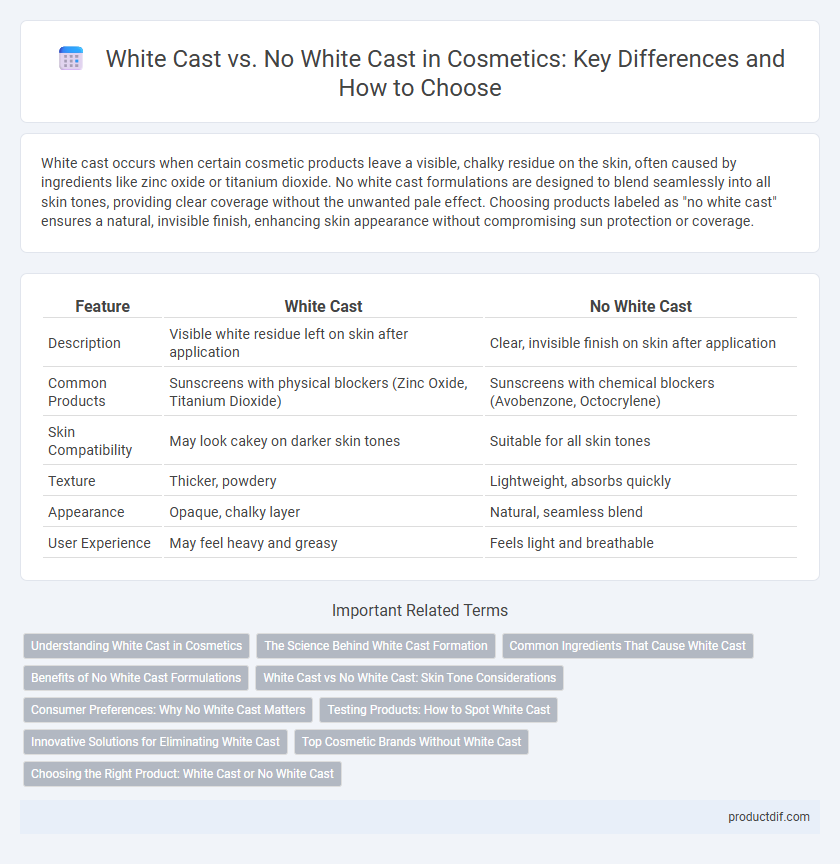White cast occurs when certain cosmetic products leave a visible, chalky residue on the skin, often caused by ingredients like zinc oxide or titanium dioxide. No white cast formulations are designed to blend seamlessly into all skin tones, providing clear coverage without the unwanted pale effect. Choosing products labeled as "no white cast" ensures a natural, invisible finish, enhancing skin appearance without compromising sun protection or coverage.
Table of Comparison
| Feature | White Cast | No White Cast |
|---|---|---|
| Description | Visible white residue left on skin after application | Clear, invisible finish on skin after application |
| Common Products | Sunscreens with physical blockers (Zinc Oxide, Titanium Dioxide) | Sunscreens with chemical blockers (Avobenzone, Octocrylene) |
| Skin Compatibility | May look cakey on darker skin tones | Suitable for all skin tones |
| Texture | Thicker, powdery | Lightweight, absorbs quickly |
| Appearance | Opaque, chalky layer | Natural, seamless blend |
| User Experience | May feel heavy and greasy | Feels light and breathable |
Understanding White Cast in Cosmetics
White cast in cosmetics refers to the visible residue or film left on the skin after applying products, often caused by ingredients like zinc oxide or titanium dioxide used in sunscreens. This effect can make the skin appear lighter or ashy, which is undesirable for many users, especially those with darker skin tones. Understanding the formulation and choosing products labeled as "no white cast" helps ensure seamless blending and natural-looking coverage without residue.
The Science Behind White Cast Formation
White cast in cosmetics results from the light-reflecting properties of mineral-based UV filters such as zinc oxide and titanium dioxide, whose larger particle sizes scatter visible light and create a white residue on the skin. Nanotechnology reduces particle size to enhance transparency, allowing these minerals to absorb UV radiation effectively without visible whitening. The balance between particle size, concentration, and formulation matrix determines whether a product leaves a white cast or blends seamlessly into various skin tones.
Common Ingredients That Cause White Cast
Common ingredients that cause white cast in cosmetics include zinc oxide and titanium dioxide, which are prevalent in physical sunscreens due to their mineral-based UV protection. These ingredients reflect light, creating a visible white residue on the skin, especially on darker tones. Alternatives like chemical UV filters or micronized minerals help achieve clear, no white cast formulas favored in modern cosmetic formulations.
Benefits of No White Cast Formulations
No white cast formulations in cosmetics offer significant benefits by providing a natural, transparent finish that blends seamlessly with diverse skin tones. These products avoid the visible residue often left by mineral sunscreens or physical blockers, enhancing user confidence and comfort. Formulations free of white cast also improve aesthetic appeal, making them ideal for daily wear and optimal use in makeup routines.
White Cast vs No White Cast: Skin Tone Considerations
White cast in cosmetics often appears as a visible residue on the skin, particularly with sunscreens containing physical UV filters like zinc oxide or titanium dioxide, which can be more noticeable on darker skin tones. No white cast formulations use micronized or transparent ingredients that blend seamlessly, ensuring even application without altering natural skin color. Selecting products without white cast is crucial for individuals with medium to deep skin tones to maintain a natural, radiant appearance while providing effective sun protection or coverage.
Consumer Preferences: Why No White Cast Matters
Consumers prefer cosmetics with no white cast because it ensures a natural, invisible finish on all skin tones, avoiding the chalky residue commonly seen with mineral-based sunscreens. A no white cast formula enhances user satisfaction by blending seamlessly into the skin, allowing for versatile daily wear without altering the complexion. Brands that prioritize this feature cater to diverse audiences, increasing product appeal and market competitiveness.
Testing Products: How to Spot White Cast
Testing cosmetic products for white cast involves applying a thin layer on a small skin area and observing any visible residue or opaque film after drying. Products with white cast often contain high levels of zinc oxide or titanium dioxide, which can leave a chalky appearance on darker skin tones. Choosing formulas labeled as "sheer," "invisible," or "no white cast" and testing under natural light ensures accurate assessment of product transparency and skin blending.
Innovative Solutions for Eliminating White Cast
Innovative cosmetic formulations incorporating micronized zinc oxide and titanium dioxide particles effectively eliminate the white cast commonly associated with traditional sunscreens, ensuring a transparent finish on diverse skin tones. Advanced encapsulation technologies and nano-emulsion systems enhance ingredient dispersion, promoting seamless absorption without residue. These breakthroughs enable products to provide broad-spectrum UV protection while maintaining aesthetic appeal and user satisfaction.
Top Cosmetic Brands Without White Cast
Top cosmetic brands without white cast deliver sheer, natural-looking coverage by using innovative formulas with micronized pigments and translucent blends. Brands like Fenty Beauty, Glossier, and ILIA prioritize inclusivity and lightweight textures, ensuring flawless application on all skin tones without the dreaded white residue. Choosing products from these leaders enhances your beauty routine by providing breathable, non-irritating finishes that seamlessly blend into the skin.
Choosing the Right Product: White Cast or No White Cast
Choosing the right cosmetic product depends largely on skin type and desired finish, where formulas with white cast often contain physical sunscreens like zinc oxide or titanium dioxide providing broad-spectrum UV protection. No white cast products typically use chemical filters that blend seamlessly into the skin, ideal for darker complexions seeking invisible coverage without residue. Prioritizing ingredients, SPF level, and potential for white cast ensures optimal sun protection while maintaining natural skin appearance.
White Cast vs No White Cast Infographic

 productdif.com
productdif.com